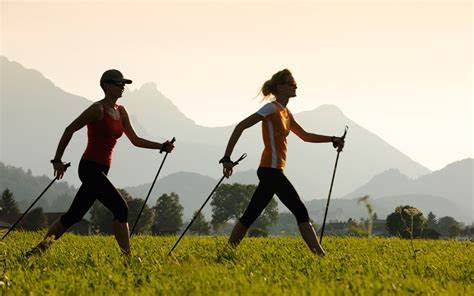✅ URL Slug
www.drmoodylifestyle.com/5-types-of-walking-and-their-fitness-benefits
✅ Introduction:
5 Types of Walking and Their Fitness Benefits might surprise you with how much they differ—and how much they can improve your health. Walking isn’t just a casual activity; it’s a versatile, low-impact form of exercise that can be tailored for weight loss, cardiovascular health, strength, and endurance.
Whether you’re strolling through the park or climbing a hill with a weighted pack, every step counts towards better health. Let’s break down the five main types of walking and the science-backed benefits they offer.
🥾 1. Casual or Leisure Walking

What It Is:
This is the most basic form—walking at a slow, comfortable pace, usually under 3 mph, like a walk in the park.
Benefits:
- Reduces stress and anxiety
- Supports joint health
- Improves mood and cognitive function
- Great for seniors or beginners
Ideal For:
- Mental relaxation
- Recovery days
- Family outings
🏃 2. Brisk or Power Walking

What It Is:
Power walking is faster (around 4–5 mph), arms bent at 90 degrees, and involves more exaggerated movements.
Benefits:
- Burns more calories than casual walking
- Improves cardiovascular endurance
- Strengthens legs, glutes, and core
- Low-impact alternative to jogging
Ideal For:
- Weight loss
- Heart health
- Quick workouts during breaks
🎒 3. Rucking (Walking with a Weighted Backpack)

What It Is:
Rucking involves walking while carrying weight in a backpack—often used in military training.
Is Rucking a Good Exercise?
Yes! It’s an excellent full-body, strength-endurance hybrid workout.
Benefits:
- Burns more calories than regular walking
- Builds core, shoulders, and legs
- Improves posture and bone density
- Can be customized by adjusting the weight
Ideal For:
- Building strength and endurance
- Men and women who want a challenge
- Outdoor fitness enthusiasts
🏞️ 4. Hiking (Uphill/Trail Walking)
What It Is:
Hiking means walking in nature, usually with varying elevation and terrain.
Benefits:
- Improves balance and agility
- Works calves, quads, glutes, and stabilizing muscles
- Mental refreshment from nature exposure
- Great for building stamina
Ideal For:
- Stress relief
- Leg and core strength
- Exploring the outdoors
🚶♂️ 5. Nordic Walking (Pole Walking)
What It Is:
Nordic walking involves the use of specially designed poles similar to ski poles. It engages the upper body along with the lower body.
Nordic Walking Technique for Beginners:

- Keep your elbows slightly bent
- Plant the poles diagonally behind you
- Push off with your arms as you walk forward
- Maintain an upright posture
Muscles Used in Nordic Walking:
- Arms and shoulders
- Upper back (latissimus dorsi)
- Core muscles
- Legs and glutes
Benefits of Walking with Poles:
- Engages 90% of body muscles
- Increases calorie burn by up to 46%
- Reduces impact on joints
- Improves balance and coordination
- Enhances cardiovascular health
Nordic Walking Advantages and Disadvantages:
Advantages:
✅ Full-body workout
✅ Easy on joints
✅ Boosts cardiovascular and respiratory health
✅ Suitable for all ages
Disadvantages:
❌ Requires equipment (poles)
❌ Learning curve for proper technique
❌ May not be suitable for crowded areas
Nordic Walking vs Regular Walking:
| Feature | Nordic Walking | Regular Walking |
|---|---|---|
| Calorie Burn | Higher (up to 46% more) | Moderate |
| Muscles Used | Full body | Lower body only |
| Equipment Needed | Yes (poles) | No |
| Coordination Required | Higher | Basic |
| Joint Impact | Lower | Low |
Is Pole Walking Good for You?
Absolutely! Studies show that pole walking improves heart health, strengthens upper and lower body muscles, and reduces joint stress, making it ideal for people recovering from injury, older adults, and those seeking efficient cardio.
💡 What Type of Exercise Is Walking?
Walking is an aerobic, low-impact exercise that improves:
- Cardiovascular fitness
- Muscular endurance
- Mental well-being
- Bone strength (especially brisk and uphill walking)
✅ Overall Benefits of Walking (All Types):
- Weight management
- Lowers blood pressure
- Enhances mood (releases endorphins)
- Improves sleep quality
- Strengthens immune function
- Supports bone and joint health
🧠 Expert Tip:
Vary your walking type throughout the week. For example:
- Monday: Casual stroll
- Wednesday: Power walk
- Friday: Rucking session
- Sunday: Nordic walk with friends
This keeps workouts fun, effective, and balanced.
❓Frequently Asked Questions
Q1: What are the different types of walks?
There are five main types: casual walking, power walking, hiking, rucking, and Nordic walking. Each has unique health benefits and intensity levels.
Q2: Is rucking a good exercise?
Yes, rucking is a fantastic exercise that combines strength training and cardio. It’s especially effective for those wanting to lose weight and build endurance.
Q3: Is Nordic walking better than regular walking?
Nordic walking burns more calories and engages more muscles than regular walking. It’s ideal for a full-body, low-impact workout.
✅ Final Thoughts
Whether you’re looking for a gentle daily activity or a calorie-blasting full-body workout, walking has a type that fits your needs. From Nordic walking with poles to weighted rucking adventures, every style offers unique physical and mental health benefits.
Start where you are. Walk how you like. Just keep moving—because walking, in any form, is a step toward a healthier you.
✅ Target Keywords:
- 5 types of walking and their fitness benefits
- types of walks
- benefits of walking
- Nordic walking advantages and disadvantages
- Nordic walking technique for beginners
- muscles used in Nordic walking
- walking with poles benefits
- Nordic walking vs regular walking
- Is rucking a good exercise
- what type of exercise is walking
- is pole walking good for you
